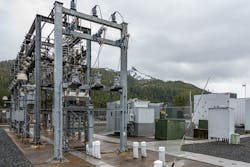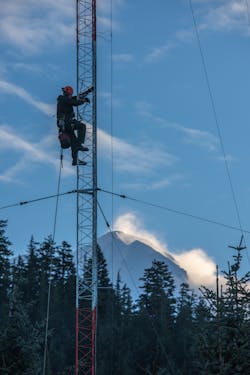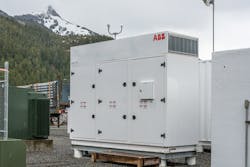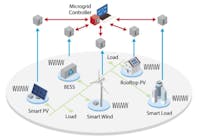About 150 miles from Anchorage, Alaska, the town of Cordova is powered by a remote microgrid owned and operated by Cordova Electric Cooperative (CEC). As a remote, isolated community, Cordova’s electrical system is not connected by roads or electric lines to other communities.
About 2,300 people live in the town year-round, but the population doubles during fishing season, placing highly seasonal electrical loads on the network. Each spring, as seasonal workers arrive and fish-processing plants ramp up for the busy months ahead, the town’s peak electricity demand more than triples from the winter peak.
To provide electricity to the residents and tourists, CEC constructed a hydropower facility and buried its power lines underground to eliminate risk of outages from storms or line contacts. In addition, CEC invested in energy storage to maximize hydropower and provide even more reliable power to its community.
Exploring Energy Storage
Back in 1907, Cordova built hydropower plants for central power to the community, and the town has been operating as a functioning, remote, microgrid for more than 110 years. Recently, CEC optimized its microgrid, and one of the key components of the plan was a battery energy storage system (BESS) to help CEC to regulate the electrical system and maximize the use of locally produced hydroelectric power.
The BESS system came online in 2019, and with the BESS-supported microgrid in place, CEC has been able to reduce its dependence on diesel and move closer to its goals for sustainability, reliability and long-term management of the town’s electrical system.
Enabled by ABB technology, CEC’s BESS provides additional spinning reserve; this allows CEC to take full advantage of the hydropower generation potential. To balance system loads, the ABB system is coupled with Li-Ion batteries to replace diesel or hydro power for grid frequency stabilization. The BESS is fully automated to work as the main CEC microgrid frequency forming source when excess water is not available to perform this service with hydro. With the BESS, CEC expects to save between 40,000 and 50,000 gallons of diesel fuel a year.
Installing the Battery System
CEC worked with ABB to install the equipment at the Cordova Electric substation on the shores of Eyak Lake on the ancestral homelands of the Eyak people. The CEC staff members were actively engaged in all aspects of the BESS project, from specification to procurement to vendor selection to site preparation and equipment installation, power and control wiring, commissioning, tuning and optimization.
The installation required extensive planning, logistics management, construction, programming and operation. For his contributions to the project, one CEC employee, Nate Cain, was awarded a Northwest Public Power Association electric utility industry award.
CEC has agreements with ABB and SAFT, the Lithium-Ion Battery supplier, to perform some of the annual maintenance and train CEC staff to perform the six-month maintenance intervals of cleaning, inspecting, changing air filters and other relatively light scheduled maintenance. CEC employees and Electric Power Systems, the company’s contract system integrator, programmed the BESS to operate automatically 24/7 on the CEC grid and to notify operators on call of any alarms or maintenance needs. The fully automated system allows CEC’s employees to all work the same 4 p.m. to 10 p.m. shift together and otherwise leave the system unmanned and unsupervised.
Discovering Benefits and Challenges
To date, the most notable benefits have been diesel fuel savings, reduced diesel generator operations and maintenance, reduced demand for total diesel plant capacity and more excess hydropower for future applications. CEC has already installed an automated, dispatchable electric boiler for diesel “keep warm” service and expects to save 10,000-15,000 gallons of diesel with the excess hydro the BESS provides in addition to the BESS direct fuel savings.
Challenges include the remote location, limited human capital and support resources and environmental factors. The climate, which averages 150 in. of annual precipitation, high winds and numerous freeze-thaw cycles in its maritime rainforest, is mitigated through design, quality equipment and additional shielding from elements.
In addition to environmental concerns, cost is also a major factor in delivering electricity to the town, and CEC prefers to run on hydropower as much as possible due to the economic advantages. Hydropower alone meets as much as 78% of annual demand, but one of the key goals of the microgrid optimization project has been to recover the hydropower lost during transition periods between 100% hydro operations and diesel-supplement operations.
For example, the hydroelectric projects provide almost all of CEC’s power in the summer, and a good portion of its power, in the winter, but because they are run-of-the river projects, they don't store any energy at all and do not always have enough excess to provide spinning reserve. Without a dam to store the water, hydro power is a “use-it-or-lose-it” proposition. CEC needed a way to maximize hydro output by avoiding the use of deflected hydropower to balance system loads.
The BESS system now provides this spinning reserve, liberating up to 1,300 kW of hydro capacity which has helped the cooperative to break hydroelectric production records. November 2019 hydro production was over 95%, and December was over 84%, breaking all previous winter records. Through the new BESS system, CEC also achieved 100% hydro nearly three weeks earlier than normal in 2020 despite colder than usual spring temperatures.
Integrating Renewables
Although CEC has developed its own strategy for integrating technology onto its grid, Alaska has a long history of integrating renewables into remote diesel grids. Many remote communities across the state are looking to diversify away from heavy reliance on diesel fuel for electricity, and more than 30 of them have already incorporated renewables into their supply.
For CEC and others, having more renewables capacity more often is creating additional excess power, which is providing the opportunity for more renewables applications like air-source heating and electric vehicle charging. The cooperative’s vision is to have a self-sufficient, sustainable electrical system used not only for electricity generation, but for home heating and for charging electric vehicles, planes, and boats as well. The Electrify Alaska! Virtual conference co-hosted by CEC this November showcased these opportunities, and CEC hopes to host a follow-up live conference in fall of 2021.
CEC’s recent efforts, with the support from its partners, including ABB, have continued the Alaskan legacy of leadership in using advanced technology and renewables to create sustainable, lower-cost, and highly reliable power.
The BESS project represents a major milestone in renewable adoption for CEC and the town of Cordova, Alaska. It is a significant move toward energy independence and the ultimate goal of eliminating use of fossil fuels throughout the community.
Clay Koplin is the CEO of Cordova Electric Cooperative and the mayor of Cordova, Alaska.









